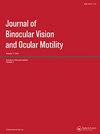Factors Influencing the Success of Atropine Penalization Treatment in Amblyopia Patients Non-Responsive to Occlusion Treatment
Q3 Medicine
Journal of Binocular Vision and Ocular Motility
Pub Date : 2022-09-06
DOI:10.1080/2576117X.2022.2114385
引用次数: 0
Abstract
ABSTRACT Purpose To evaluate the efficacy of atropine penalization after non-response to patch therapy in amblyopic children and investigate the factors associated with treatment success. Patients and Methods In this retrospective study, 26 children with amblyopia who were non-responders to patch therapy who were then switched to 1% atropine eye drops in the sound eye for a minimum follow-up of one year were included. All patients underwent detailed eye examinations, including optical coherence tomography and fundus autofluorescence (FAF) imaging. Response to treatment was defined as a two-line improvement in best-corrected visual acuity (BCVA) in the amblyopic eye, and patients were divided into two groups: the responder group and the non-responder group. Demographic and clinical parameters were compared between the two groups. The average central macular thickness and FAF were analyzed. Results Sixteen of 26 patients (61.5%) showed treatment response. The mean age of the patients was 10.62 ± 3.42 (5–17) years. There was no difference between the groups in age, age at start of patch therapy, sex, follow-up period, refractive errors, type of amblyopia, reason for patch therapy non-response, or mean effective patching time per day. In the responder group, the LogMAR values of pretreatment BCVA, BCVA after optical correction, and BCVA after occlusion were significantly higher, but BCVA after atropine treatment showed no difference. FAF images of all patients were normal, and the mean central macular thickness did not significantly differ between the groups. Conclusions Atropine penalization can improve BCVA in children with amblyopia who are non-responders to patch therapy. Atropine penalization may be more successful in children with poor BCVA at the start of atropine penalization in the amblyopic eye. The results of FAF imaging and mean central macular thickness were not associated with treatment outcomes.影响对遮挡治疗无反应的弱视患者阿托品惩罚治疗成功的因素
目的评价弱视儿童贴片治疗无效后阿托品惩罚的疗效,探讨影响治疗成功的因素。患者和方法在这项回顾性研究中,纳入了26名弱视儿童,他们对贴片治疗无反应,然后在至少一年的随访中在健全的眼睛中切换到1%阿托品滴眼液。所有患者都进行了详细的眼科检查,包括光学相干断层扫描和眼底自身荧光(FAF)成像。对治疗的反应定义为弱视眼最佳矫正视力(BCVA)的两条线改善,患者分为两组:反应组和无反应组。比较两组患者的人口学和临床参数。分析平均黄斑中央厚度和FAF。结果26例患者中有16例(61.5%)治疗有效。患者平均年龄为10.62±3.42(5-17)岁。各组在年龄、贴片治疗开始年龄、性别、随访时间、屈光不正、弱视类型、贴片治疗无反应的原因或平均每天有效贴片时间等方面无差异。在反应组中,预处理BCVA、光学矫正后BCVA、闭塞后BCVA的LogMAR值均显著升高,而阿托品治疗后BCVA无差异。所有患者FAF图像均正常,组间黄斑中央平均厚度无显著差异。结论阿托品惩罚可改善对贴片治疗无反应的弱视儿童的BCVA。在弱视开始阿托品惩罚治疗时,对BCVA差的儿童,阿托品惩罚治疗可能更成功。FAF成像结果和平均黄斑中央厚度与治疗结果无关。
本文章由计算机程序翻译,如有差异,请以英文原文为准。
求助全文
约1分钟内获得全文
求助全文
来源期刊

Journal of Binocular Vision and Ocular Motility
Medicine-Ophthalmology
CiteScore
1.20
自引率
0.00%
发文量
42
 求助内容:
求助内容: 应助结果提醒方式:
应助结果提醒方式:


